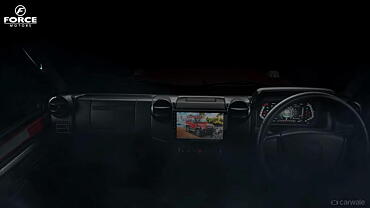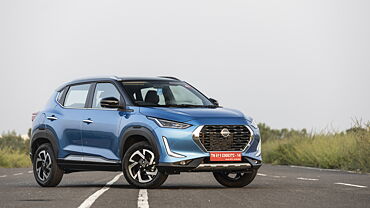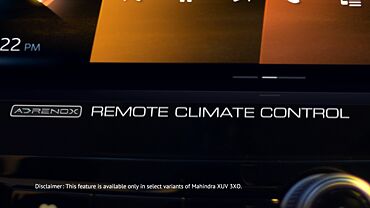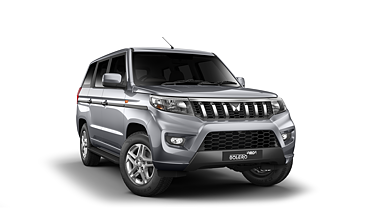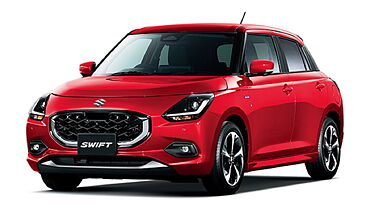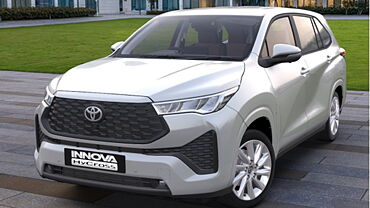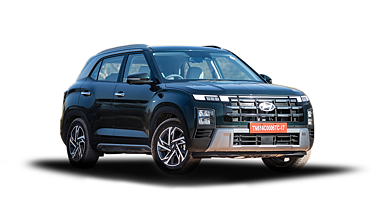Cartrade Comparison Test
The Toyota Innova Crysta has been in the CarTrade garage multiple times in the past few months. In the previous test it has ousted the Mahindra XUV 500, its then arch-rival (read more here). Now though, we have lined up its natural and perhaps its toughest contender yet in the form of the all-new Tata Hexa.
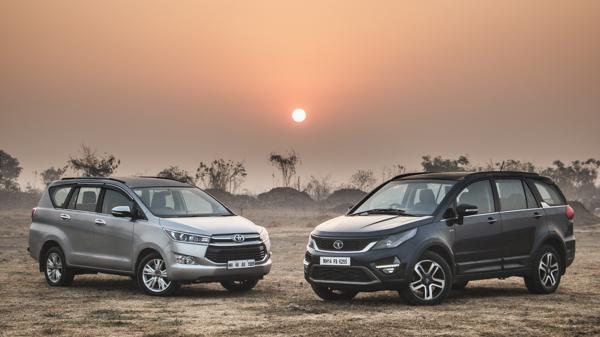
Both are XXL-sized people carriers loaded with flexible seating and lots of space. That said, it’s the newer Hexa that tries harder to please the families, at least on paper – it’s noticeably longer and wider than the Innova Crysta and also comes with 4x4 hardware which the Toyota lacks.
Clearly Tata is betting big on the Hexa but can it really cause an uproar and challenge the Innova Crysta which has positively taken forward its predecessor’s legacy?
Exterior
It’s an open secret that the Hexa is related to the old Aria in a few ways including the exterior design. Nonetheless, where the Aria came across as curvy and typically MPV-ish, the Hexa represents an aggressive yet stylish take on the full-size MPV space. It manages this with its towering height, beefy wheel arches and a good chunk of body cladding. The Hexa even has a couple of nice elements like the chrome-laced honeycomb grille and those gorgeous looking 19-inch alloys. Ultimately, the Hexa is big, brawny and everything many Indians look for in a vehicle of this size.
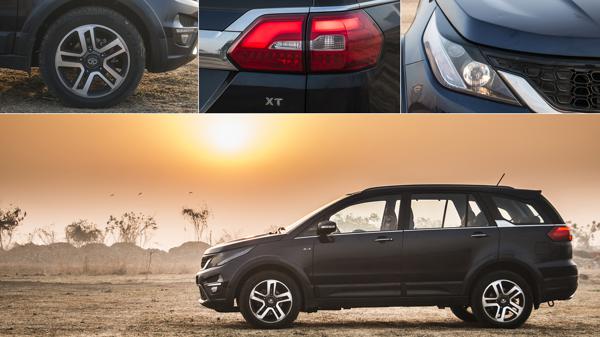
Toyota isn’t really known for daring styling, especially for its MPV range. That said, the brand has livened up its popular workhorse for good. As far as generation changes go, the Crysta is a far cry from the old model; gone is the old meek and boring looking silhouette and in its place is a design which is a lot more expressive. The front-end in particular grabs attention with its large hexagonal grille and the twin-slat chrome grille that merges neatly into the headlamps. Now although these upgrades have added fair bit of muscle, the Crysta still has that whiff of people-carrier look around its rear-end.
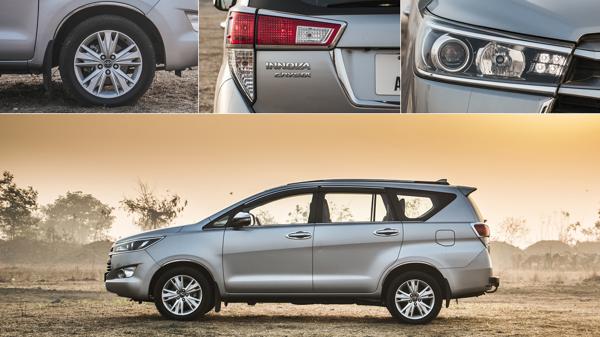
Interior
The Hexa may resemble the Aria on the outside, however, step inside the cabin and it’s a whole different story. The all-black cabin is unlike anything else you’ve seen on a Tata despite some component sharing. The dash in fact is layered with plenty of hexagonal chrome elements for the center vents, side vents and the infotainment system. The quality and feel of the gloss black finish and soft grain plastic is rather impressive and adds to the premium feel.
What the Innova Crysta may sacrifice in terms of exterior design, it makes up for in practicality and convenience. Everything from the design, layout and the material has changed for the good, well nearly. Yes, the dashboard is more cluttered than before but it’s thoroughly modern nonetheless. What’s more, the Crysta relies on better build quality and superb ergonomics to distance itself from the Hexa. The differences, in fact, come through in the detail – the buttons and dials have a tactile feel and the leather-wrapped steering wheel feels great to hold as well. In the Toyota you will also find tighter shut lines with the glovebox and softly padded door armrests and the sun visors. In Comparison, the Hexa’s dash top is finished in hard plastic that doesn’t match the soft door trim. The Hexa fights back in a few areas though. The perforated leather seats not only look premium but also lend a plush feel and the rotary dial for the drive modes is a nice touch, too.
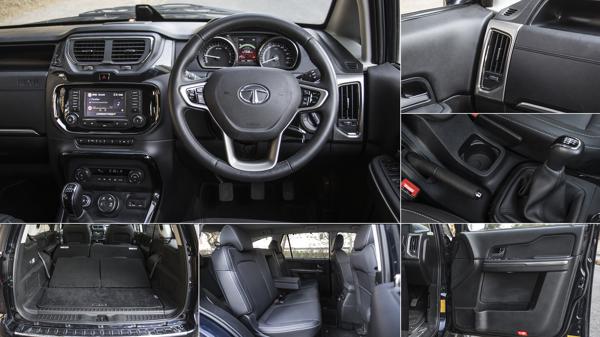
Upfront, both offer a towering driving position but in the Hexa you tend to sit a little higher. Having said that, it’s the Innova’s front seat that will be prove to be more comfortable over longer journeys – it’s got better spaced out bolsters and the seat base is marginally longer as well. Move onto the rear and things are slightly different. In here, the Hexa betters its more expensive rival by offering a larger rear bench with relatively flat contours for better shoulder support. Those seated in the back of the Hexa will also appreciate the abundance of legroom and headroom on offer.

Despite their bulk, the third row in both these vehicle is mediocre at best when it comes to accommodating two adults. The combination of a high floor and low seat means you end up sitting in a cramped manner with your knees locked in. That said, it’s the Hexa again which fares better as a seven-seater, offering more knee space and bigger windows compared to the Innova Crysta.
As for the all-important equipment, both these vehicles (in top-spec trim) are loaded with multiple airbags, ABS, EBD, electrically adjustable driver’s seat, climate control, rear AC vents, electrically foldable mirrors, rear camera and some more. The Hexa however misses out on keyless entry/start whereas sunroof is missing on both.
Performance
For this test we are comparing the manual gearbox-equipped models. In this spec, the Hexa gets a 156bhp/400Nm 2197cc, 4-cylinder motor which is mated to a 6-speed manual. The Innova, on the other hand, pairs a 150bhp/340Nm 2393cc unit with a more traditional 5-speed gearbox.
On paper, the Hexa trounces its Japanese rival however the figures aren’t enough when you consider the fact that it’s over 300kg heavier (mainly because of 4x4 hardware). The extra bulk plays spoilsport right from the word go – the Hexa feels lethargic and heavy below 2,000rpm. It is after this point that this engine delivers a solid midrange punch, one that surprisingly stays on till the redline. Contrary to rivals with big capacity engines, the Hexa boasts of strong top-end and makes great progress when its engine is all worked up. Sadly, the same cannot be said for the 6-speed gearbox which isn’t apt for quick shifting at all. The gearshifts, in fact, are notchy and rather imprecise. Add to that the long throws and the uneven clutch action and the Hexa (in manual spec, at least) is quite a handful.

Even though it’s down on power, more so on torque, the Innova Crysta is significantly more responsive around town. The engine’s extra torque low down makes the Toyota heaps more effortless to get up to speed than the Hexa. Even though its midrange or top-end isn’t as strong as the Hexa, the Innova makes up for it with its 5-speed gearbox which again is effortless and more car-like.
There is no doubt the Hexa and the Innova feel divergent in their paths to power, however, they are surprisingly close when it comes to steering feel and ride quality. The Innova may be more responsive around town but it still demands some effort from the driver – it’s hydraulically assisted steering rack is heavy and can be vague at times. The Hexa’s steering is equally heavy though it manages to provide a more linear feedback throughout. As for the ride quality, at slow speeds both these vehicles are closely matched; they remain composed over uneven patches but tend to be upset by sharp potholes. The Hexa’s massive tyres, in particular, snag on sharp-edged potholes, affecting the otherwise nicely balanced damping.

The Innova’s low-speed ride matches up to the Hexa, but at highway speeds its reactions differ from the latter. Whereas the Hexa is simply unfazed and remains more composed over bad roads, the Innova starts to wallow and pitches over the same bumps. Perhaps what’s surprising is that there is less road noise in the Tata than the Toyota – the Hexa simply offers better insulation from underneath and the engine compartment.
Conclusion
It is a testament to Tata that in terms of ride quality, NVH and seat comfort, the Hexa genuinely challenges the mighty Toyota, and wins it. At Rs 17.49 lakh ex-showroom, the Hexa eclipses the Innova Crysta for price as well.
Ultimately, though, the Innova justifies its higher price tag in several key areas. It may cost nearly 20 lakh ex-showroom, but in the overall scheme of things, it’s a much better all-rounder. Not only is it heaps more responsive than the Hexa and more car-like to drive in traffic, the Innova is now a proper long distance hauler, thanks to more power and better spaced out gear ratios.
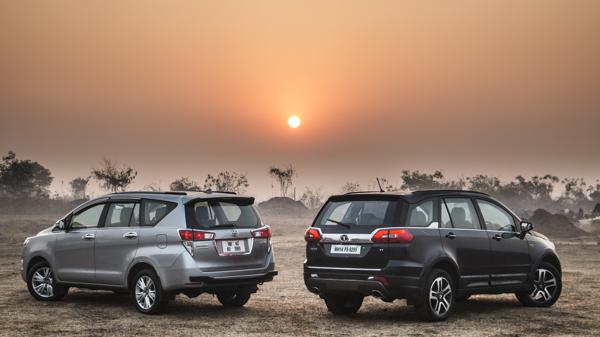
The revamp to Crysta has only made us appreciate this MPV all the more. It ticks all the practicality boxes and adds a dose of style that had been missing in the Innova for so long.



![Toyota Innova Crysta [2020-2023] Toyota Innova Crysta [2020-2023]](https://imgd-ct.aeplcdn.com/160x89/n/cw/ec/51435/innova-crysta-exterior-right-front-three-quarter-3.jpeg?q=80)
